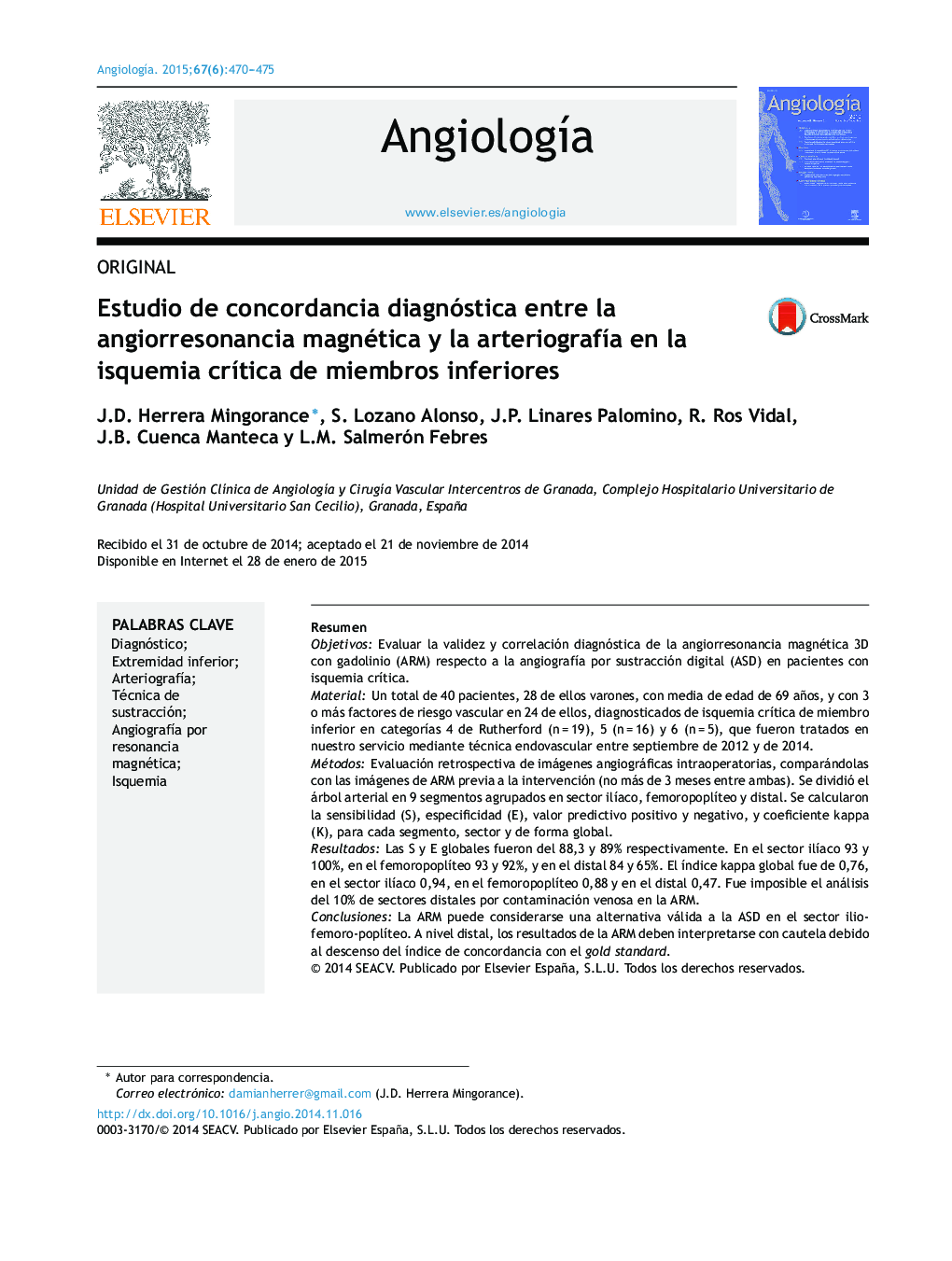| کد مقاله | کد نشریه | سال انتشار | مقاله انگلیسی | نسخه تمام متن |
|---|---|---|---|---|
| 2867483 | 1171089 | 2015 | 6 صفحه PDF | دانلود رایگان |

ResumenObjetivosEvaluar la validez y correlación diagnóstica de la angiorresonancia magnética 3D con gadolinio (ARM) respecto a la angiografía por sustracción digital (ASD) en pacientes con isquemia crítica.MaterialUn total de 40 pacientes, 28 de ellos varones, con media de edad de 69 años, y con 3 o más factores de riesgo vascular en 24 de ellos, diagnosticados de isquemia crítica de miembro inferior en categorías 4 de Rutherford (n = 19), 5 (n = 16) y 6 (n = 5), que fueron tratados en nuestro servicio mediante técnica endovascular entre septiembre de 2012 y de 2014.MétodosEvaluación retrospectiva de imágenes angiográficas intraoperatorias, comparándolas con las imágenes de ARM previa a la intervención (no más de 3 meses entre ambas). Se dividió el árbol arterial en 9 segmentos agrupados en sector ilíaco, femoropoplíteo y distal. Se calcularon la sensibilidad (S), especificidad (E), valor predictivo positivo y negativo, y coeficiente kappa (K), para cada segmento, sector y de forma global.ResultadosLas S y E globales fueron del 88,3 y 89% respectivamente. En el sector ilíaco 93 y 100%, en el femoropoplíteo 93 y 92%, y en el distal 84 y 65%. El índice kappa global fue de 0,76, en el sector ilíaco 0,94, en el femoropoplíteo 0,88 y en el distal 0,47. Fue imposible el análisis del 10% de sectores distales por contaminación venosa en la ARM.ConclusionesLa ARM puede considerarse una alternativa válida a la ASD en el sector ilio-femoro-poplíteo. A nivel distal, los resultados de la ARM deben interpretarse con cautela debido al descenso del índice de concordancia con el gold standard.
ObjectivesTo evaluate the validity of 3-D magnetic resonance angiography (MRA) with gadolinium and compare the diagnostic results with digital subtraction angiography (DEA) in patients with critical limb ischemia.MaterialThe study consisted of 40 patients diagnosed with lower limb critical ischemia treated using an endovascular technique in our unit between September 2012 and September 2014. There were 28 males. The mean age was 69 years, and 24 of them had more than 3 vascular risk factors. They had Rutherford scores of 4 (n = 19, 5 (n = 16), and 6 (n = 5).MethodsA retrospective evaluation was performed on the intra-operative angiography images, comparing them with the MRA images obtained before the intervention (no more than 3 months between them). The arterial tree was divided into 9 segments, grouped in the iliac, femoropopliteal and distal sectors. The sensitivity (S), specificity (Sp), positive and negative predictive values, and kappa coefficient (K) for each segment, as well as overall.ResultsThe overall S and Sp was 88.3 and 89%, respectively. In the iliac sector, it was 93 and100%, in the femoropopliteal, 93 and 92%, and in the distal 84 and 65%, respectively. The overall kappa index was 0.76, with 0.94 in the iliac sector 0.88 in the femoropopliteal, and 0.47 in the distal. The analysis of 10% of the distal sectors was impossible, due to venous contamination in the MRA.ConclusionsMRA may be considered as a valid alternative to DSA in the iliac-femoropopliteal sector. At distal level, the MRA results should be interpreted with caution due to the decrease in the concordance index with the gold standard.
Journal: Angiología - Volume 67, Issue 6, November–December 2015, Pages 470–475